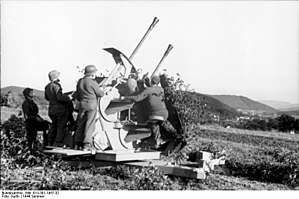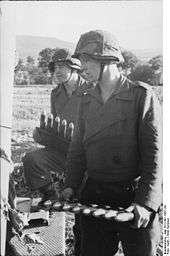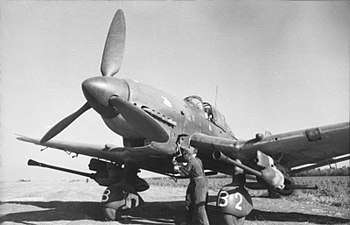3.7 cm Flak 18/36/37/43
| 3.7 cm Flak 18/36/37/43 | |
|---|---|
 A 3.7 cm Flakzwilling 43 | |
| Type | Anti-aircraft cannon |
| Place of origin | Nazi Germany |
| Service history | |
| In service | 1936–45 |
| Used by | Nazi Germany, Romania, Bulgaria |
| Wars | World War II |
| Production history | |
| Designer | Rheinmetall |
| Produced | 1936–45 |
| No. built |
20,243[1] (Germany) 360[2] (Romania) |
| Variants |
BK 37 aircraft gun, 3.7 cm Flakzwilling 43 |
| Specifications (3.7 cm Flak 43[1]) | |
| Weight | 2,000 kg (4,400 lb) (transport) |
| Barrel length | 3.626 m (142.8 in) |
| Crew | 6–7 |
|
| |
| Shell | 37 × 263 mm. B |
| Shell weight | 623–659 g (1.373–1.453 lb) |
| Caliber | 37 mm (1.5 in) |
| Barrels | 57 calibers |
| Breech | gas-operated bolt |
| Carriage | three-legged platform |
| Elevation | -7° 30' to +90° |
| Traverse | 360° |
| Rate of fire | 150 rpm (practical), 250 rpm (theoretical) |
| Muzzle velocity | 770–820 m/s (2,500–2,700 ft/s) |
| Effective firing range | 4,200 m (4,600 yd) (anti-aircraft) |
| Maximum firing range | 7,995 m (8,743 yd) (ground range) |
| Feed system | 8-round clips |
The 3.7 cm Flak 18/36/37/43 was a series of anti-aircraft cannon produced by Nazi Germany that saw widespread service in the Second World War. The cannon was fully automatic and effective against aircraft flying at altitudes up to 4,200 m.[3] The cannon was produced in both towed and self-propelled versions. Having a flexible doctrine, the Germans used their anti-aircraft pieces in ground support roles as well; 37 mm caliber guns were no exception to that. With Germany's defeat, production ceased and, overall, 37 mm caliber anti-aircraft cannon fell into gradual disuse, being replaced by the Bofors 40 mm gun and later, by 35-mm anti-aircraft pieces produced in Switzerland.
Development
The original 37 mm gun was developed by Rheinmetall in 1935 as the 3.7 cm Flak 18. It had a barrel length of 57 calibers (hence the additional designation L/57), which allowed 4,800 m (15,700 ft) maximum ceiling.[1] The armour penetration was considerable when using dedicated[4] ammunition, at 100 m distance it could penetrate 36 mm of a 60°-sloped armour, and at 800 m distance correspondingly 24 mm.[1] It used a mechanical bolt for automatic fire, featuring a practical rate of fire of about 80 rounds per minute (rpm). The gun, when emplaced for combat, weighed 1,750 kg (3,860 lb), and complete for transport, including the wheeled mount, 3,560 kg (7,850 lb).
The Flak 18 was only produced in small numbers, and production had already ended in 1936. Development continued, focusing on replacement of the existing cumbersome dual-axle mount with a lighter single-axle one, resulting in a 3.7 cm Flak 36 that cut the complete weight to 1,550 kg (3,420 lb) in combat and 2,400 kg (5,300 lb) in transport.[1] The gun's ballistic characteristics were not changed, although the practical rate of fire was raised to 120 rpm (250 rpm theoretical).[1] A new, simplified sighting system introduced the next year produced the otherwise-identical 3.7 cm Flak 37.[1] The Flak 37 was known as 37 ITK 37 in Finland.
The Flak 36/37 were the most-produced variants of the weapon.
Tun antiaerian Rheinmetall calibru 37 mm model 1939
In 1938, the Kingdom of Romania acquired the license to locally produce 360 guns, officially known as "Tun antiaerian Rheinmetall calibru 37 mm model 1939" ("37 mm Rheinmetall anti-aircraft cannon model 1939") at the Astra factory in Brașov.[2] By May 1941, 102 had been built, and by October 1942, the production rate was 6 pieces per month.[5]
Flakpanzer Mareșal
In June 1944, the Germans proposed an anti-aircraft version of the Romanian Mareșal tank destroyer, armed with twin 37 mm anti-aircraft guns, a design which was named Flakpanzer Mareșal. However, this proposed design never left the drawing board.[6]
Flak 43

The 3.7 cm Flak 43 was a dramatic improvement over older models. A new gas-operated breech increased the practical firing rate to 150 RPM,[1] while at the same time dropping in weight to 1,250 kg (2,760 lb) in combat, and 2,000 kg (4,400 lb) in transport.[1] It was also produced in a twin-gun mount, the 3.7 cm Flakzwilling 43,[1] although this version was considered somewhat unwieldy and top-heavy.[7]
Many Flak 37s were mounted on the ubiquitous Sd.Kfz. 7 half-track vehicle, or later the schwere Wehrmachtschlepper (sWS), but the newer Flak 43 was almost always used in a mobile mounting. Most famous of these were the converted Panzer IVs, first the "interim" Möbelwagen, and later the Ostwind.
Large-scale production did not start until 1944 and some 7,216 had been produced by the end of the war (Zwillings included, each counted as two guns).[8]
Aviation version

The earlier Flak 18 version of the 37mm autoloading gun was adapted for aviation use as the BK 3,7, the lightest-calibre model of the Bordkanone series of heavy caliber cannon used in Luftwaffe aircraft during the war. The BK 3,7 was usually employed for strike against ground targets, or for bomber destroyer duties. Mounted within self-contained gun pods or in conformal gondola-style flat-surface mounted gunpod housings, the BK 3,7 saw use on the Ju 87G panzerknacker ("tank-cracker") version of the Stuka dive bomber as flown with considerable success by Hans-Ulrich Rudel, the Ju 88P-2 and P-3 subtypes, and the Hs 129 B-2/R3 twin-engined strike aircraft.
Similar weapons
The closest Allied counterpart to the 3.7 cm Flak series was the 40 mm Bofors L/60, which was designated the "4 cm Flak 28" in German service. The Bofors fired a larger shell of 900 grams (32 oz), as opposed to around 650 grams (23 oz), at a slightly higher muzzle velocity of around 880 metres per second (2,900 ft/s) as opposed to just under 800 metres per second (2,600 ft/s). This gave the Bofors an effective ceiling of about 4,938 metres (16,201 ft) compared to 4,200 metres (13,800 ft) for the Flak series.[9] Firing rates for the earlier models were similar, although the Flak 43's improved rates beat the Bofors. The most notable difference is the size and weight of the two weapons; the Bofors weighed just under 2,000 kilograms (4,400 lb) and required a two-axle trailer, while the earlier Flak models weighed 1,550 kilograms (3,420 lb) on a single-axle mount, and the Flak 43 reduced this even further to 1,250 kilograms (2,760 lb).
The 37 mm automatic air defense gun M1939 (61-K) was the closest Soviet counterpart, firing a shell very similar to the Flak from a gun of generally similar weight and size. The 37, however, had a much lower cyclic rate, averaging around 80 rpm. The US's 37 mm Gun M1 was similar to the Flak as well, but was considered inferior to the Bofors and saw relatively limited use. The Japanese had nothing similar, their largest AA autocannon being the Type 96 25 mm AT/AA Gun. The Italian counterpart was the Breda Cannone-Mitragliera da 37/54.
Comparison of anti-aircraft guns
| Country | Gun Model | RPM | Projectile Weight | Weight of fire |
|---|---|---|---|---|
| 3.7 cm Flak 18/36/37/43 | 150 | .64 kg (1.4 lb)[10] | 96 kg (212 lb) | |
| 3.7 cm SK C/30 | 30 | .74 kg (1.6 lb)[11] | 22.2 kg (49 lb) | |
| Canon de 37 mm Modèle 1925 | 15-21 | .72 kg (1.6 lb)[12] | 10.8–15.12 kg (23.8–33.3 lb) | |
| Cannone-Mitragliera da 37/54 (Breda) | 60-120 | .82 kg (1.8 lb)[13] | 49.2–98.4 kg (108–217 lb) | |
| 37 mm Gun M1 | 120 | .87 kg (1.9 lb) | 104.4 kg (230 lb) | |
| 37 mm automatic air defense gun M1939 (61-K) | 80[14] | .73 kg (1.6 lb)[15] | 58.4 kg (129 lb) | |
| QF 2-pounder naval gun | 115 | .91 kg (2.0 lb)[16] | 104.6 kg (231 lb) | |
| Bofors 40 mm gun | 120 | .9 kg (2.0 lb)[17] | 108 kg (238 lb) |
Notes
- 1 2 3 4 5 6 7 8 9 10 Ivanov, A. (2003). АРТИЛЛЕРИЯ ГЕРМАНИИ ВО ВТОРОЙ МИРОВОЙ ВОЙНЕ (Artilleria Germanyi Vo Vtoroy Mirovoy Voyne) (in Russian). pp. 41–48. ISBN 978-5-7654-2634-0.
- 1 2 Third Axis - Fourth Ally, pag. 30
- ↑ Hogg, German Artillery of World War Two
- ↑ PzGr. 18 cast iron armour piercing high explosive ammunition.
- ↑ Romanian Army equipment during the Second World War (Romanian)
- ↑ Mareșal tank destroyer
- ↑ 3,7-cm Flak 43 and Flakzwilling 43, The Encyclopedia of Weapons of World War II, Chris Bishop, pp. 168
- ↑ Production Stats on German Tube-fired Weapons 1939-1945, by Jason Long
- ↑ Carruthers, Bob (2012). German Tank Hunters - The Panzerjäger. Archive Media Publishing Ltd. ISBN 978-1781581384.
- ↑ DiGiulian, Tony. "Germany 3.7 cm/57 (1.5") Flak M43 - NavWeaps". www.navweaps.com. Retrieved 2017-06-07.
- ↑ DiGiulian, Tony. "Germany 3.7 cm/83 SK C/30 - NavWeaps". www.navweaps.com. Retrieved 2017-06-07.
- ↑ DiGiulian, Tony. "France 37 mm/50 (1.46") Model 1925 and CAIL Model 1933 - NavWeaps". www.navweaps.com. Retrieved 2017-06-07.
- ↑ DiGiulian, Tony. "Italy 37 mm/54 (1.5") Models 1932, 1938 and 1939 - NavWeaps". www.navweaps.com. Retrieved 2017-06-07.
- ↑ Foss, Christopher (1977). Jane's pocket book of towed artillery. New York: Collier. p. 229. ISBN 0020806000. OCLC 911907988.
- ↑ DiGiulian, Tony. "Russia / USSR 37 mm/67 (1.5") 70-K - NavWeaps". www.navweaps.com. Retrieved 2017-06-07.
- ↑ DiGiulian, Tony. "United Kingdom / Britain 2-pdr QF Mark VIII - NavWeaps". www.navweaps.com. Retrieved 2017-06-07.
- ↑ DiGiulian, Tony. "USA Bofors 40 mm/60 Model 1936 - NavWeaps". www.navweaps.com. Retrieved 2017-06-07.
Sources
- Gander, Terry and Chamberlain, Peter. Weapons of the Third Reich: An Encyclopedic Survey of All Small Arms, Artillery and Special Weapons of the German Land Forces 1939-1945. New York: Doubleday, 1979 ISBN 0-385-15090-3
- Hogg, Ian. Twentieth-Century Artillery. New York: Barnes & Noble Books, 2000. ISBN 0-7607-1994-2 Pg.107
- Hogg, Ian V. German Artillery of World War Two. 2nd corrected edition. Mechanicsville, PA: Stackpole Books, 1997 ISBN 1-85367-480-X
External links
| Wikimedia Commons has media related to 3.7 cm FlaK 18/36/37/43. |